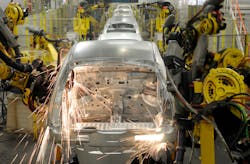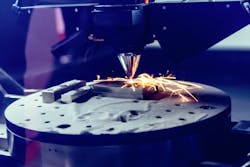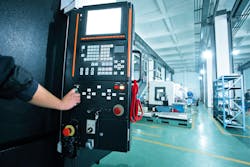How can you avoid manufacturing pitfalls in laser processing?
The reliability and repeatability of today’s laser processes allow manufacturers to produce higher-quality parts in ever-increasing volumes. Technology has advanced to the point where laser-based processes are not only more robust but more commonplace as new applications are developed every day, from sintering in additive manufacturing to e-mobility component processing.
But many pitfalls remain during deployment, operation, or maintenance of an industrial laser. Laser operators can be lulled into a false sense of security and form bad habits when it comes to maintaining a consistent laser process. These pitfalls can be attributed to several different issues, including understanding how laser light behaves in material processing applications, how modern-day laser products are different from legacy laser products, and when and where measuring a laser’s performance is important. Separating fact from fiction is critical to ensuring a high-quality laser process.
Pitfall 1
Don’t assume today’s laser processes are so stable they don’t require much monitoring (see Fig. 1). Material processing applications were developed soon after the advent of the laser in the 1950s. The CO2 laser, producing laser light at a 10.6 µm wavelength, has historically been a pillar of laser manufacturing with its raw horsepower, relatively inexpensive operating costs, and ease of maintenance. Hundreds of thousands are still in use, thanks to the work of thousands of laser operators who developed the operational and maintenance practices used today.
The 1980s saw the emergence of the 1 µm laser (fiber lasers, direct diode lasers, disk lasers) as an industrial tool, and it continues to change the landscape of industrial laser manufacturing. The 1 µm fiber brought benefits such as higher wall-plug efficiency, higher beam quality, and decreased maintenance. But it was initially expensive, did not produce output powers high enough for industrial laser applications, and was difficult to maintain. Manufacturers of 1 µm lasers have overcome most of these hurdles and are now providing more practical sources and systems. One problem is that as the 1 µm laser replaces the 10 µm (CO2) laser in industrial environments, operational and maintenance practices are not always replaced. The 1 µm laser cannot be operated and maintained as a 10 µm laser.
As high-quality and reliable as today’s laser systems have become, the user may overlook that the system is still made of physical parts with physical properties. Laser systems are comprised of mechanical and electrical components that can and will degrade or fail after periodic use. Harsh industrial environments filled with process debris only multiply the possibility and frequency of these components’ degradation and failure. The result is a laser system that has decreased efficiency, which is more expensive to operate. System designers have gotten creative in their management of process debris, but without measurement of laser system performance, the laser user cannot fully understand how these system component degradations affect the laser process or fully know how and when to take action to maximize the system’s efficiency.
Laser systems require significant financial investments to produce parts quickly and efficiently. Periodic maintenance on the system is necessary, but the obvious desire to maximize return on investment means minimizing the time it takes to maintain the system.
Pitfall 2
There are many times when having to rely on others to solve your laser problems can be costly. It’s vital for a manufacturer to have good relationships with industry experts such as applications engineers and systems integrators. These experts continuously improve ways to transform process requirements into tools that help manufacturers consistently produce high-quality parts. But things can go wrong with the laser process. When working with an invisible tool, it is not always easy to determine the source of the problem. And when laser measurement products are not included in the troubleshooting, even more time and money are needlessly spent recovering the system.
In situations such as this, laser measurement solutions quickly pay for themselves. These solutions can be used not only to establish baseline performance of the laser within the system, they can also be used to troubleshoot laser problems and return the system back to its baseline more effectively. Integrated laser measurement products can help determine changes in the laser’s status—establishing laser performance trends to help the operator develop more efficient maintenance practices, as well as aiding in troubleshooting when problems arise.
Another challenge is rooted in the difference between CO2 lasers and fiber (and similar 1 µm) lasers. CO2 lasers operate at a very forgiving 10.6 µm wavelength. The optics for them are robust, less susceptible to damage from surrounding process debris, and easier to maintain. Modern-day fiber, disk, and diode lasers operate near a 1 µm wavelength. Their optics are more susceptible to damage from debris produced within harsh industrial environments and must be handled with extreme care when being replaced. Some laser operators rely on the legacy practice of changing CO2 laser optics, but these practices ultimately cause damage to the processing heads of their 1 µm wavelength lasers if great care isn’t taken.
Pitfall 3
If the laser isn’t performing as needed, don’t just turn up the power. As previously discussed, this tends to happen in CO2 laser applications. Time is money and the laser operator, whose job performance is often tied to a quota of acceptable parts produced, knows this. When a laser starts to exhibit adverse behaviors, the laser operator usually takes the quickest action to bring the system back to normal. For example, with laser cutting applications, this often involves turning up the laser power to keep producing parts. But what may be happening is an increased thermal effect on the laser system caused by an old, damaged, or contaminated optic, usually physically close to the process. The thermal effect causes the focused spot to shift upward, resulting in decreased power density at the work site. In the case of cutting, turning up the power temporarily solves the problem, but does not address the root cause of the power loss.
Beam profiling instrumentation allows users to tune their laser processes to achieve a precise irradiance that is enough for the task, but not so intense that a weld, for example, overheats and renders less optimum results. Today’s laser measurement solutions provide the ability to better understand the performance of the laser light and to approach the operation and maintenance of the systems with more efficiency than ever before (see Fig. 2).Pitfall 4
Don’t assume taking measurements of the laser system is too expensive and time-consuming.
There is a common pitfall that the return on investment for laser measurement systems is low. This is rooted in the misconception that laser measurement solutions are expensive to purchase, and difficult to set up and use. There is also a mindset that, while laser measurement equipment is nice to have, it may not provide useful or relevant information for the application.
Historically, the cost to purchase laser measurement solutions was high.
Today, with advancements in camera technologies, optical components, networking, communications, computing power, and software, laser measurement products are smaller, faster, cheaper, and provide very relevant information about the laser. Laser power meters and beam profiling products have evolved into cost-effective maintenance tools and can integrate directly into laser work cells. For example, in welding of transmission parts, battery components, or seating components, the laser must consistently interact with the process as designed. It is increasingly common for automotive manufacturers to integrate an industrial combination power measurement and beam profiling device into their work cells to periodically monitor laser performance for purposes of trend analysis, process traceability, and smarter maintenance prediction. Those who use these tools quickly realize the return on the investment is high.
Beyond cost improvements, several advancements allow for easier operation of these products. Laser measurement systems take into consideration the needs of system integrators, as well as operators and maintenance personnel. For instance, they use industry-standard communication protocols and are designed with rugged industrial hardware connections. They also include safety enhancements to protect against damage from process debris, overheating, etc. Laser power meters and beam profiling products are widely used in scientific and research arenas and are often designed for those environments. These products are also being applied in industrial sectors because of the relevant laser performance information they supply. Because of this, their designs have been adapted to more harsh production environments.
Pitfall 5
Laser processes can’t be managed without laser measurement. In some cases, a laser application is developed, deployed, and performance is simply assumed to remain consistent; it’s forgotten until something goes wrong with the process.
There is a push in many consumer markets to provide reliable and safe products while also reducing operating costs. But with the tight parameters of many laser applications, such as the fast-focus/high-laser-power application of welding highly reflective materials, achieving a consistent laser process isn’t always easy. To ensure the laser is performing consistently over time, key performance measurements must be taken, analyzed, and proactively acted upon (see Fig. 3). When these laser parameters are not measured and are unknown, the process can drift and ultimately result in scrapped parts. For instance, if the focused spot in a copper welding application shifts from its designed position, loss of weld penetration can occur from the beam size increasing at the process. If the focus shift on the laser system is tracked, this drift can be avoided.The sustainability issue is a major consideration. There are many efforts to manufacture smarter by consuming resources more wisely to reduce the impact on the planet. Anyone who has been involved in these initiatives knows that every little improvement to a process helps. Measuring, trending, and analyzing laser performance, and also taking action to maintain consistent laser performance helps. A properly maintained laser system will consume less power and maximize throughput, which is not only good for reducing operating costs, but also good for our planet.
Pitfall 6
Not all legacy laser measurement technologies are time-tested and provide adequate information about a laser. Some laser service personnel still use very simple tools for maintaining and troubleshooting problems. Laser “power pucks,” acrylic mode blocks, and phosphor-coated fluorescent plates, for example, are all quick and easy to use. But these legacy products paint a very incomplete picture of how a laser is performing at any given time.
With these methods, a laser is fired into a bulk thermal device for several seconds, which produces a single number corresponding to output power. The laser beam is imaged into an acrylic block or fluorescent plate and subjectively analyzed without any trending data or industry standards of measurement. Today’s electronic laser measurement products provide time-based measurements that allow for short- or long-term trend analysis of laser performance, which are calibrated against NIST-traceable standards, and use ISO-compliant methods of beam measurement. This provides a more comprehensive analysis of laser characteristics and confidence in the accuracy of the measurements.
With Industry 4.0, the demand for feedback from machine tools is proving very valuable for improving industrial processing. The laser, when viewed as a machine tool, is no exception. Products can now provide information about the laser’s performance characteristics with a couple of different approaches. In-process or in situ measurement can provide real-time feedback on how the laser is operating, but often only analyzes part of the system, limiting the information that’s supplied. On the other hand, at-process measurement products provide a more complete analysis of how the laser is performing at the point of processing, but these products must be used between part runs, so it isn’t quite real-time in its nature.
Today’s laser user should be encouraged to continuously improve the processes for which they are responsible. Those who work in manufacturing are always looking for ways to improve processes. This translates into saved time and decreased costs that directly affects the company’s bottom line. Apart from process improvement, the laser can sometimes be a difficult tool to operate, maintain, and troubleshoot. Because of this, there are times when laser processes are neglected. Don’t rely on myths. Measurement of your laser’s performance, either through standalone or integrated products, is one of the best ways to accomplish these goals. It is the responsible thing to do, for the company, planet, and yourself.

John McCauley
John McCauley is senior business development manager for MKS Ophir, with a focus on automotive and directed energy applications. Previously, he served as their Midwest regional sales manager and product specialist for all markets. Since 1998, his background has been as an end user of, and an applications engineer working with, laser marking and engraving systems. He has also worked closely with several mid-Indiana metal fabricating customers.


